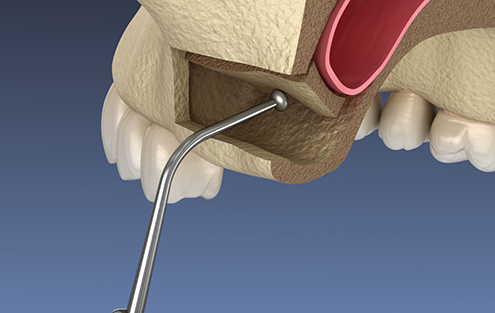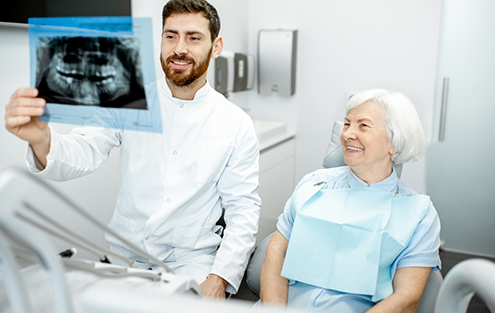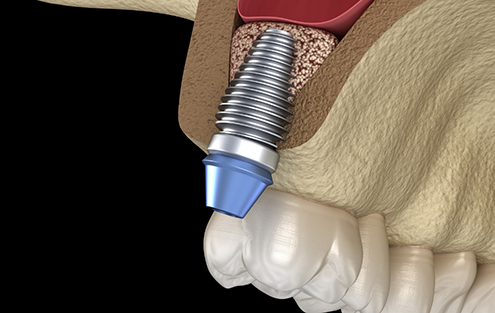Sinus Lifts Torrance
We Can Prepare Your Upper Jaw for Dental Implants

Without question, dental implants are the best form of tooth replacement that modern dentistry has to offer. However, they come with a complex treatment process, and our team needs to be sure that your mouth can adequately support them. If we find that your upper jaw is not currently large enough or thick enough to accommodate implants, our Torrance team of experts might recommend that you undergo a sinus lift. This special oral surgery can prepare your upper jaw for dental implants and set you up for long-term success with your new smile, so call us today to learn mroe about sinus lifts in Torrance.
Why Choose Blue Coast Dental Group for Sinus Lifts?
- Esteemed Oral Surgeon Ready to Help
- Three Types of Dental Sedation Available
- Flexible Financing Available Through CareCredit
What Is a Sinus Lift?

Essentially, a sinus lift is a special type of bone graft that is performed exclusively in the upper dental arch. When the upper jaw is too thin, placing dental implants is risky because they could penetrate the sinus membrane above it, leading to significant complications. A sinus lift mitigates that risk because the procedure involves lifting the sinus membrane. Once it is lifted, a bone graft is placed beneath it to thicken the upper jaw and keep the sinus in its new place.
Do I Need a Sinus Lift?

There are several reasons why your upper jaw might not be thick enough to support dental implants:
- You lost your natural teeth some time ago. Without tooth roots to stimulate the jawbone, it tends to become thinner and weaker as the months and years pass.
- You have a naturally thin upper jaw or naturally large sinus. These anatomical features are usually the result of genetics.
- You had advanced gum disease. Advanced gum disease can cause significant damage to the jawbone. When this occurs in the upper dental arch, it can interfere with your mouth’s ability to support dental implants.
- You are older. Bone health problems are more common in older individuals.
The Sinus Lift Process

One of the first things we will do during your appointment is make you comfortable. In addition to administering local anesthesia, we may also sedate you. We offer a few different types of sedation; we will choose the one that best fits your unique situation.
Once you are settled in, we will make small incisions in your gum tissue so we can access the jawbone. Next, we will create an opening in the jawbone so we can gently push the sinus membrane upward. We then place a block of bone material, perhaps from a donor or an artificial source, beneath the membrane. To finish the surgery, we close the incisions in the gums.
The soft tissue at the surgical site should heal within a few weeks. However, full recovery and integration of the bone graft can take 4 – 9 months. After that period, you may be eligible to receive dental implants in your upper jaw.
Would you like to learn more about sinus lift surgery? Contact Blue Coast Dental Group in Torrance today to ask questions or request a consultation.
Sinus Lift FAQs
Where Does the Bone Come from for a Sinus Lift?
The bone for dental bone grafts, including sinus lifts, can come from various sources. For example, we might perform an autograft, which involves taking bone from your own body and moving it to your upper jawbone. This minimizes the risk of rejection but does necessitate multiple surgical sites. Or we might perform an allograft, wherein the bone comes from an outside source, such as another human or an animal. Allografts are carefully processed so they are as safe as possible. In some cases, we might use synthetic bone materials.
What Can I Expect While Recovering from a Sinus Lift?
Some soreness, swelling, and minor bleeding might occur during the first few days of your recovery. After a few weeks, the soft tissue at the surgical site should be fairly well-healed, though it can take several months for the bone beneath it to completely recover.
Our team will give you detailed post-op instructions to minimize discomfort and promote your body’s healing process. For example, we may urge you to get plenty of rest, avoid smoking, eat a soft diet, and be very careful when performing oral hygiene tasks near your surgical site. If you have a denture or another removable prosthetic for your upper dental arch, you may need to avoid using it for a while.
Are There Any Risks Involved with Sinus Lift Surgery?
No medical or dental procedure is completely risk-free. With that being said, it is important to note that our team is very serious about patient safety. We take every reasonable precaution to minimize the risk of adverse outcomes. For example, we thoroughly screen patients before approving them for any oral surgery. We also adhere to strict infection control measures.
If you have questions about the potential risks of sinus lift surgery, talk with us during your consultation.
Will a Sinus Lift Affect My Breathing, Allergies, or Sinus Health?
We are very careful not to damage the sinus membrane during sinus lift surgery. There should be no long-lasting impact on your breathing, allergies, or sinus health. If you have anatomical abnormalities that are affecting your ability to breathe through your nose, a different procedure may be the best way to address them.
